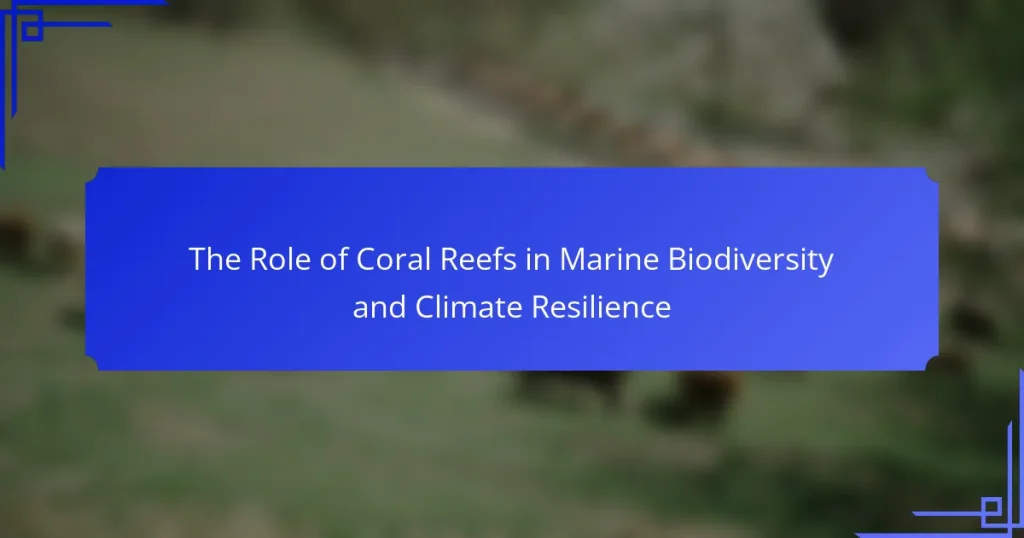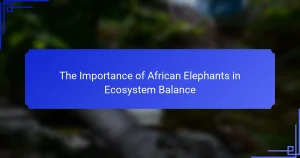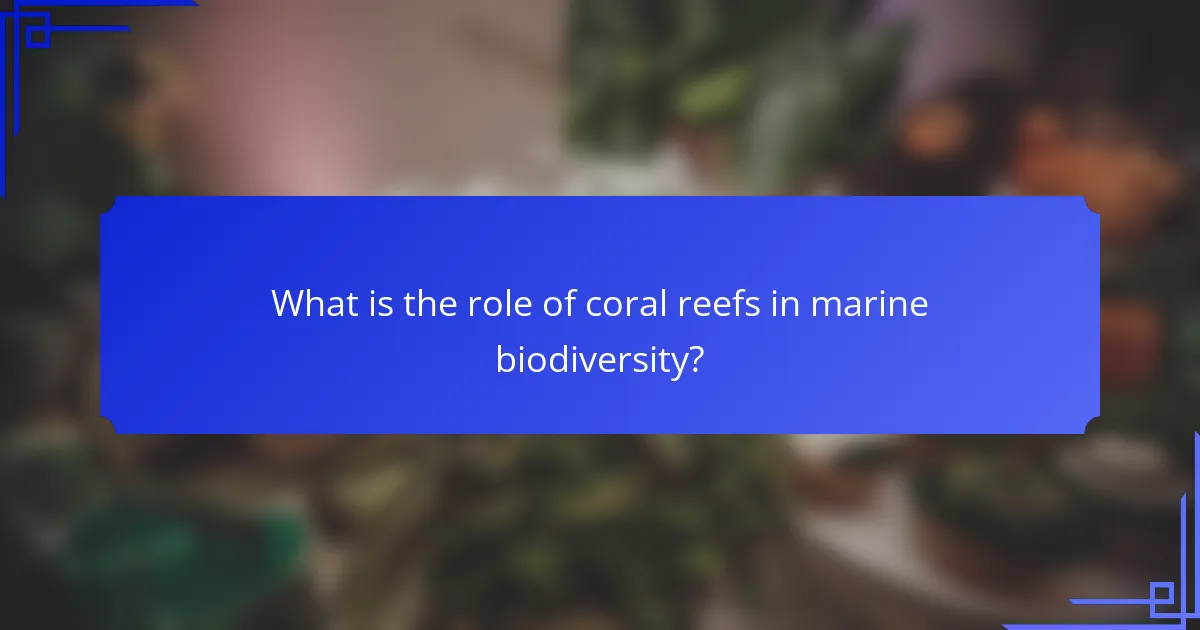
What is the role of coral reefs in marine biodiversity?
Coral reefs play a critical role in marine biodiversity. They provide habitat and shelter for approximately 25% of all marine species. This includes fish, invertebrates, and other organisms. Coral reefs contribute to the overall health of marine ecosystems. They support complex food webs and nutrient cycling. Additionally, they act as nursery grounds for many commercially important fish species. The biodiversity of coral reefs also enhances resilience against environmental changes. Healthy coral reefs can better withstand stressors like climate change and pollution.
How do coral reefs contribute to the diversity of marine life?
Coral reefs enhance the diversity of marine life by providing essential habitats. These ecosystems support over 25% of all marine species despite covering less than 1% of the ocean floor. Coral reefs offer shelter, breeding grounds, and food sources for various marine organisms. They host thousands of fish species, invertebrates, and other marine life that rely on this complex environment. The structural complexity of coral reefs creates niches for different organisms, promoting biodiversity. Additionally, coral reefs contribute to nutrient cycling, which supports a wide range of species. Studies show that healthy coral reefs can sustain diverse marine populations and enhance ecosystem resilience.
What types of species are commonly found in coral reef ecosystems?
Coral reef ecosystems host a diverse array of species. Commonly found species include various types of corals, fish, mollusks, and crustaceans. Coral species such as stony corals and soft corals provide essential habitat. Fish species like clownfish, parrotfish, and butterflyfish thrive in these environments. Mollusks, including sea snails and clams, contribute to the ecosystem’s complexity. Crustaceans such as shrimp and crabs play vital roles in nutrient cycling. Studies indicate that coral reefs support approximately 25% of all marine species. This biodiversity is crucial for ecosystem stability and resilience.
How do coral reefs provide habitat and shelter for marine organisms?
Coral reefs provide habitat and shelter for marine organisms through their complex structures. These structures are formed by calcium carbonate secreted by coral polyps. The intricate formations create numerous nooks and crannies. These spaces offer protection from predators for various species. Many fish, invertebrates, and other marine life depend on these habitats for survival.
Additionally, coral reefs support diverse ecosystems. They attract a wide range of marine organisms, fostering biodiversity. Research indicates that reefs support approximately 25% of all marine species. This high level of biodiversity is crucial for maintaining ecological balance. Coral reefs also contribute to the overall health of marine environments.
Why are coral reefs considered vital to ocean health?
Coral reefs are vital to ocean health because they support marine biodiversity and protect coastal ecosystems. These structures provide habitat for approximately 25% of all marine species. Coral reefs also act as natural barriers against storm surges and coastal erosion. They contribute to the livelihoods of millions of people through fishing and tourism. Furthermore, coral reefs play a significant role in carbon cycling and nutrient recycling in marine environments. Research indicates that healthy coral reefs can enhance fish populations and improve water quality. The decline of coral reefs can lead to diminished marine life and increased vulnerability of coastal communities.
What ecological functions do coral reefs perform?
Coral reefs perform essential ecological functions that support marine biodiversity. They provide habitat for approximately 25% of all marine species. Coral reefs also act as natural barriers, protecting coastlines from erosion and storm surges. They contribute to nutrient cycling in marine ecosystems. Coral reefs support fisheries by serving as breeding and feeding grounds. They facilitate tourism and recreation, boosting local economies. Coral reefs play a critical role in carbon sequestration, helping to mitigate climate change. These functions underscore the importance of coral reefs in maintaining healthy marine environments.
How do coral reefs impact nutrient cycling in marine environments?
Coral reefs significantly impact nutrient cycling in marine environments. They promote the recycling of nutrients through complex biological processes. Coral polyps host symbiotic algae called zooxanthellae. These algae perform photosynthesis, converting sunlight into energy and releasing organic compounds. These compounds serve as food for the corals, enhancing their growth and health.
As corals grow, they contribute to the structure of the reef, providing habitat for various marine species. This biodiversity fosters interactions among organisms, further enhancing nutrient cycling. For instance, fish and invertebrates feed on algae and detritus, redistributing nutrients throughout the ecosystem.
Research indicates that coral reefs can increase local nutrient availability by up to 50% compared to non-reef areas. This nutrient enrichment supports primary productivity in surrounding waters. Thus, coral reefs play a crucial role in maintaining the balance of marine ecosystems through their influence on nutrient cycling.
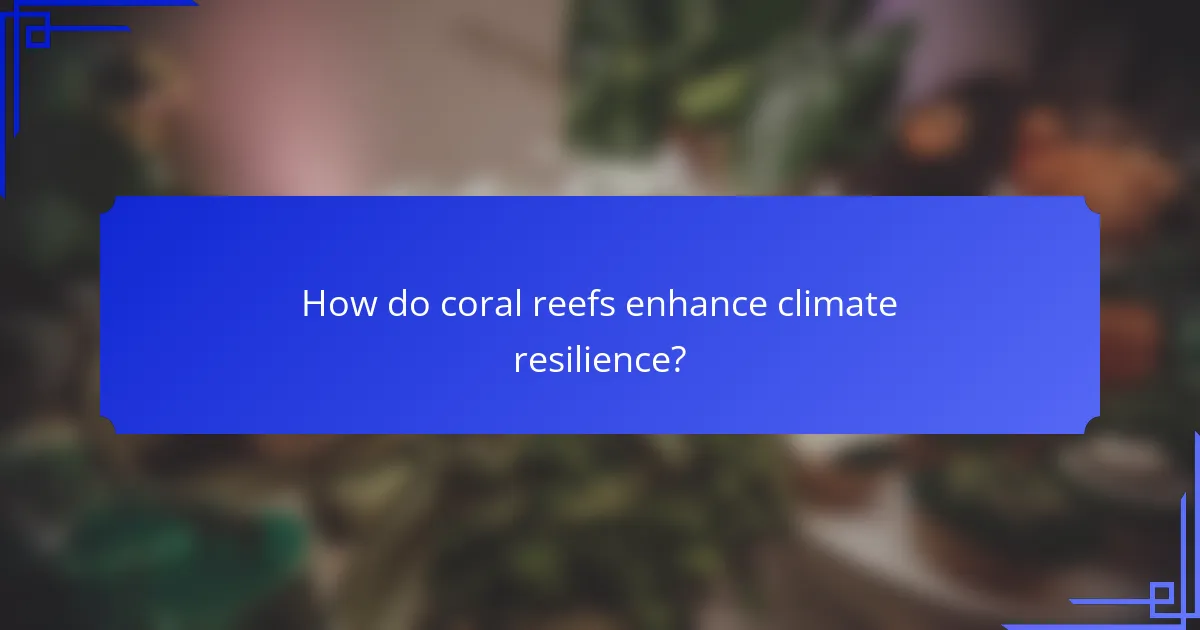
How do coral reefs enhance climate resilience?
Coral reefs enhance climate resilience by acting as natural barriers against storm surges and coastal erosion. They reduce wave energy, protecting shorelines and human settlements. Research indicates that healthy coral reefs can decrease wave impact by up to 97%. This function helps maintain coastal ecosystems and biodiversity. Additionally, coral reefs support fish populations that are vital for food security. They contribute to carbon cycling, sequestering carbon dioxide effectively. The biodiversity within coral reefs also increases ecosystem stability, allowing for better adaptation to climate change. Overall, coral reefs provide critical services that mitigate climate-related impacts.
What mechanisms do coral reefs use to protect coastlines?
Coral reefs protect coastlines through several mechanisms. They act as natural barriers against wave energy. This reduces coastal erosion and protects shorelines from storm surges. Coral structures dissipate the energy of incoming waves. They also trap sediments, promoting beach formation. Healthy reefs support diverse marine life, which contributes to ecosystem stability. Studies show that areas with robust coral reefs experience less damage during storms. The presence of coral reefs can reduce wave height by up to 50%. These protective functions are vital for coastal communities and ecosystems.
How do coral reefs mitigate the effects of storm surges and erosion?
Coral reefs mitigate the effects of storm surges and erosion by acting as natural barriers. They absorb wave energy, reducing the impact of incoming waves. This absorption decreases the intensity of storm surges that reach coastal areas. Research indicates that coral reefs can reduce wave height by up to 97%. Their complex structures dissipate energy and protect shorelines from erosion. Healthy coral reefs also promote sediment stabilization. This stabilization further reduces coastal erosion, preserving habitats and human infrastructure. Studies show that areas with healthy reefs experience less damage during storms compared to those without.
What role do coral reefs play in carbon sequestration?
Coral reefs play a significant role in carbon sequestration. They absorb carbon dioxide from the atmosphere through photosynthesis by symbiotic algae called zooxanthellae. This process converts carbon dioxide into organic matter, which is stored in coral tissues. Additionally, coral reefs contribute to the formation of calcium carbonate structures. These structures sequester carbon over long periods. Research indicates that coral reefs can store up to 1.6 billion tons of carbon annually. This storage helps mitigate climate change effects by reducing atmospheric carbon levels. Thus, coral reefs are vital for carbon sequestration and climate resilience.
Why is the health of coral reefs important for climate adaptation?
The health of coral reefs is crucial for climate adaptation because they provide essential ecosystem services. Coral reefs act as natural barriers, protecting coastlines from storm surges and erosion. They also support marine biodiversity, which contributes to resilient ecosystems. Healthy reefs enhance fish populations, ensuring food security for coastal communities. Additionally, coral reefs play a role in carbon sequestration, helping to mitigate climate change effects. Studies show that intact coral reefs can reduce wave energy by up to 97%, significantly lowering the impact of extreme weather events. Therefore, maintaining coral reef health is vital for both environmental stability and human livelihoods in the face of climate change.
How do healthy coral reefs contribute to ecosystem stability?
Healthy coral reefs contribute to ecosystem stability by providing habitat and food for diverse marine species. They support approximately 25% of all marine life despite covering less than 1% of the ocean floor. Coral reefs act as natural barriers, protecting coastlines from erosion and storm damage. This function helps maintain the integrity of coastal ecosystems. Additionally, coral reefs facilitate nutrient cycling, which is vital for the health of marine environments. They also enhance biodiversity, allowing for more resilient ecosystems. Studies show that diverse ecosystems are better equipped to withstand environmental changes. Healthy coral reefs thus play a crucial role in maintaining overall marine ecosystem stability.
What are the implications of coral reef degradation on climate resilience?
Coral reef degradation significantly undermines climate resilience. Healthy coral reefs act as natural barriers against storm surges and coastal erosion. When reefs degrade, coastal communities become more vulnerable to extreme weather events. This vulnerability increases due to the loss of biodiversity that healthy reefs support. Biodiversity contributes to ecosystem stability and resilience against climate change impacts. The decline in fish populations from degraded reefs also affects food security for local communities. Studies show that degraded reefs can lead to a 50% increase in coastal flooding risk. Therefore, the implications of coral reef degradation extend beyond environmental concerns to socioeconomic impacts.
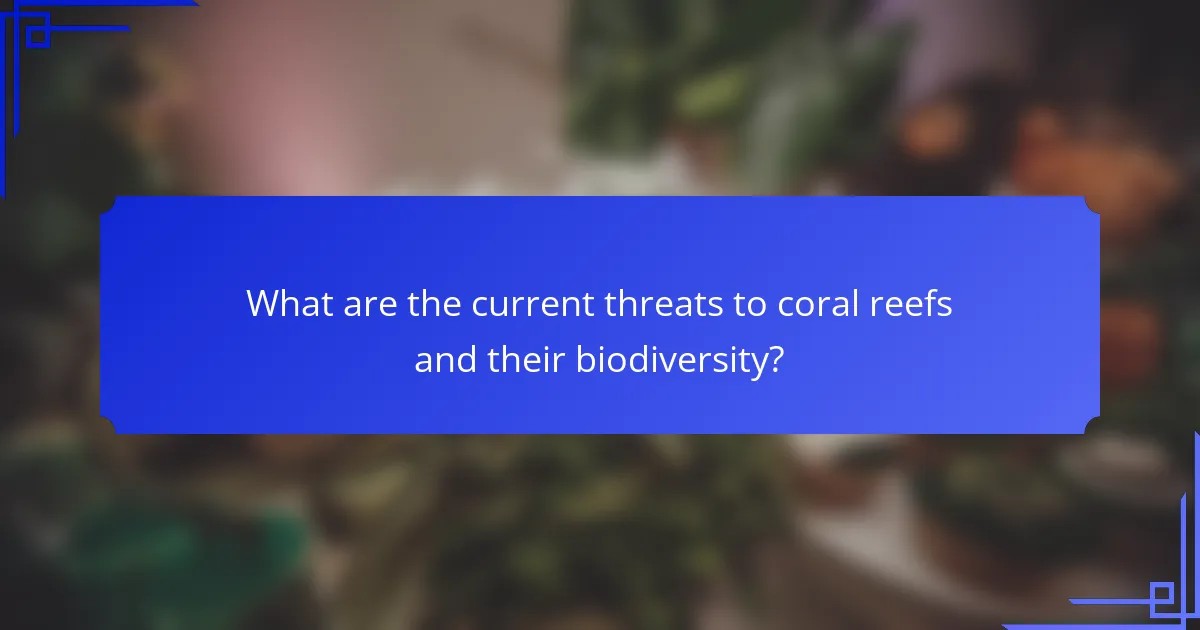
What are the current threats to coral reefs and their biodiversity?
Coral reefs face significant threats that jeopardize their biodiversity. Climate change leads to ocean warming and acidification, causing coral bleaching. Overfishing disrupts the ecological balance, reducing fish populations that rely on reefs for habitat. Pollution from agricultural runoff introduces harmful nutrients and toxins, degrading water quality. Coastal development destroys natural habitats, further threatening reef ecosystems. Invasive species outcompete native organisms, diminishing biodiversity. These factors collectively contribute to the decline of coral reefs and their associated marine life.
How do climate change and ocean acidification affect coral reefs?
Climate change and ocean acidification significantly harm coral reefs. Rising ocean temperatures lead to coral bleaching, which occurs when corals expel the symbiotic algae that provide them with color and nutrients. This process weakens corals, making them more susceptible to disease and mortality. Ocean acidification reduces the availability of carbonate ions, essential for coral calcification. As a result, corals struggle to build their calcium carbonate skeletons, impeding growth and structural integrity. Studies indicate that coral reefs could decline by 70-90% by 2050 if current trends continue. The combination of these stressors threatens not only coral health but also the diverse marine ecosystems that depend on them.
What specific changes occur in coral reefs due to rising sea temperatures?
Coral reefs experience bleaching due to rising sea temperatures. Elevated temperatures stress coral organisms, leading to the expulsion of symbiotic algae called zooxanthellae. This loss of algae results in the coral’s white appearance, known as bleaching. Bleached corals are more susceptible to disease and have reduced reproductive success. Additionally, rising temperatures can disrupt the delicate balance of marine ecosystems. This disruption affects fish populations that rely on coral reefs for habitat and food. Studies indicate that prolonged bleaching can lead to significant coral mortality. Research shows that coral reefs may decline by up to 70% if sea temperatures rise by 1.5°C above pre-industrial levels.
How does ocean acidification impact coral growth and health?
Ocean acidification negatively impacts coral growth and health. Increased carbon dioxide in the atmosphere leads to higher levels of carbonic acid in ocean water. This process reduces the availability of carbonate ions, which are essential for coral calcification. Corals rely on these ions to build their calcium carbonate skeletons. As a result, lower carbonate ion concentrations hinder coral growth and structural integrity. Research indicates that ocean acidification can lead to decreased coral diversity and increased susceptibility to diseases. Studies show that coral reefs may experience significant declines in health by 2100 if acidification continues at the current rate.
What human activities threaten coral reef ecosystems?
Human activities that threaten coral reef ecosystems include coastal development, overfishing, pollution, and climate change. Coastal development leads to habitat destruction and sedimentation. Overfishing disrupts the balance of marine life and depletes key species. Pollution from agricultural runoff introduces harmful chemicals and nutrients into the water. Climate change causes ocean warming and acidification, which negatively impacts coral health. According to the National Oceanic and Atmospheric Administration (NOAA), approximately 75% of coral reefs are currently threatened by human activities. These threats collectively jeopardize the biodiversity and resilience of coral reef ecosystems.
How do overfishing and pollution affect coral reefs?
Overfishing and pollution significantly harm coral reefs. Overfishing disrupts the balance of marine ecosystems. It removes key species that help maintain coral health. This leads to an increase in algae, which can smother corals. Pollution introduces harmful substances into the water. Nutrient runoff from agriculture can cause algal blooms. These blooms block sunlight needed for coral photosynthesis. Additionally, pollutants can weaken coral structures and make them more susceptible to disease. Studies show that areas with high pollution levels have lower coral diversity and health. This decline in coral reefs affects marine biodiversity and resilience to climate change.
What are the consequences of coastal development on coral reefs?
Coastal development has significant negative consequences on coral reefs. It leads to habitat destruction, which directly impacts coral health and biodiversity. Increased sedimentation from land clearing smothers corals and reduces sunlight [censured]. Pollution from construction runoff introduces harmful chemicals, affecting coral growth and resilience. Coastal development also alters water flow, disrupting nutrient supply essential for coral survival. Overfishing associated with development depletes fish populations that help maintain coral ecosystems. These factors contribute to coral bleaching, a phenomenon linked to rising water temperatures. Studies indicate that regions with high coastal development experience accelerated coral decline. For instance, research by Hughes et al. (2017) highlights that coral cover can decrease by over 50% in heavily developed areas.
What actions can be taken to protect coral reefs and enhance their resilience?
To protect coral reefs and enhance their resilience, several actions can be taken. Establishing marine protected areas (MPAs) restricts harmful activities like overfishing and pollution. Implementing sustainable fishing practices prevents depletion of fish stocks critical to reef health. Reducing carbon emissions mitigates climate change impacts, which cause coral bleaching. Promoting coral restoration projects helps rehabilitate damaged reefs. Educating communities about the importance of coral reefs fosters conservation efforts. Supporting research on coral genetics aids in developing resilient strains. Lastly, reducing plastic waste decreases ocean pollution that harms coral ecosystems.
Coral reefs are critical entities in marine biodiversity, providing habitat for approximately 25% of all marine species and supporting complex ecosystems. This article explores the various roles of coral reefs, including their contributions to nutrient cycling, climate resilience, and coastal protection. It examines the impact of human activities and climate change on coral health and biodiversity, highlighting the importance of maintaining healthy reefs for ecological stability. Additionally, it discusses actionable strategies for protecting coral reefs and enhancing their resilience against ongoing environmental threats.
